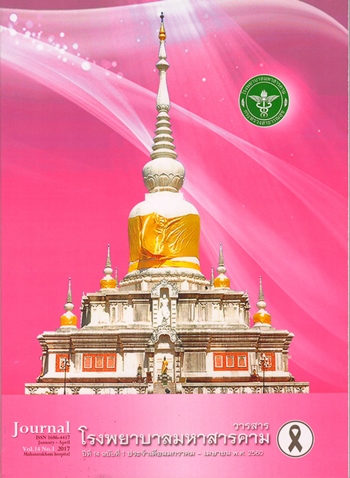ความชุกและปัจจัยเสี่ยงที่เกี่ยวข้องกับอาการปวดคอ ปวดไหล่และปวดบริเวณแขนถึงปลายมือในบุคลากรที่ปฏิบัติงานในสำนักงานโรงพยาบาลสรรพสิทธิประสงค์
บทคัดย่อ
วัตถุประสงค์: เพื่อศึกษาความชุกของอาการปวดคอ ไหล่ปวดบริเวณแขนถึงปลายมือ ในบุคลากรที่ปฏิบัติงานในสำนักงานโรงพยาบาลสรรพสิทธิประสงค์และปัจจัยที่เกี่ยวข้องกับอาการปวด
รูปแบบการวิจัย: การศึกษาเชิงพรรณนา ณ ช่วงเวลาใดเวลาหนึ่งโรงพยาบาลสรรพสิทธิประสงค์ จังหวัดอุบลราชธานีของบุคลากรที่ปฏิบัติงานในสำนักงานโรงพยาบาลสรรพสิทธิประสงค์
ผลการวิจัย: จากแบบสอบถามที่ส่งไปในบุคลากรทั้งหมด 320 คน แบ่งเป็นเพศชาย 95 คน เพศหญิง 225 คน อายุเฉลี่ย 40.6 ±10.3 ปี พบค่าความชุกของอาการปวดคอ ไหล่ปวดบริเวณแขนถึงปลายมือ ในบุคลากรที่ปฏิบัติงานในสำนักงาน โรงพยาบาลสรรพสิทธิประสงค์จำนวน 302 คน (ร้อยละ 94.4 ) เมื่อวัดความรุนแรงของอาการปวดด้วย Visual Analog Scale (VAS) พบว่าระดับความรุนแรงน้อย (0 < VAS <3) 110 คน (ร้อยละ 34.4%) ระดับความรุนแรงปานกลาง (3 ≤ VAS <5) 93 คน (ร้อยละ 29.1) และระดับความรุนแรงมาก (5 ≤ VAS ≤10) 99 คน (ร้อยละ 30.9) ตำแหน่งที่มีอาการปวดมากที่สุดคือ คอ จำนวน 188 คน (ร้อยละ 58.8) พบว่าอาการปวดคอ ไหล่และปวดบริเวณแขนถึงปลายมือ สัมพันธ์กับลักษณะงานที่ใช้คอมพิวเตอร์ ระยะเวลาการใช้คอมพิวเตอร์ ระยะเวลาการใช้คอมพิวเตอร์ต่อเนื่อง อย่างมีนัยสำคัญทางสถิติ (P value = 0.001, P value = 0.001 และ P value = 0.001 ตามลำดับ)
สรุป: ความชุกของของอาการปวดคอ ไหล่ปวดบริเวณแขนถึงปลายมือ ในบุคลากรที่ปฏิบัติงานในสำนักงานโรงพยาบาลสรรพสิทธิประสงค์อยู่ในเกณฑ์สูง ส่วนใหญ่มีระดับความรุนแรงของอาการเพียงเล็กน้อย ตำแหน่งที่มีอาการปวดมากสุดคือ คอ ปัจจัยที่สัมพันธ์กับอาการปวดคือลักษณะงานที่ใช้คอมพิวเตอร์ ระยะเวลาการใช้คอมพิวเตอร์ ระยะเวลาการใช้คอมพิวเตอร์ต่อเนื่อง
คำสำคัญ: อาการปวดคอและไหล่, ปัจจัยเสี่ยง, บุคลากรสำนักงาน
เอกสารอ้างอิง
Lin TY, Teixeira MJ, Fischer AA, et al. Work-related musculoskeletal disorders. Phys Med rehabil Clin N Am 1997;8(1):113-7
Bongers PM, de Winter CR, Kompier MA, et al. Psychosocial factors at work and musculoskeletal disease. Scand J Work Environ Health 1993;19:297-312.
Guidotti TL. Occupational repetitive strain injury. Am Fam Physician. 1992;45:585-592.
Rempel DM, Harrison RJ, Barnhart S. Work-related cumulative trauma disorders of the upper extremity. JAMA 1992;267:838-2.
T Korhonen, R Ketola, R Toivonen, et al. Work related and individual predictors for incident neck pain among office employees working with video display units. Occup Environ Med. 2003;60:475-82
Carolyn M Sommerich, Sharon MB Joines. Effects of computer Monitor Viewing Angle and related Factors on Strain, Performance, and preference Outcomes. Human Factors. 2001;43:39-55
Fredriksson K, Alfredsson L, Ahlberg G, et al. work environment and neck and shoulder pain: the influence of exposure time. Results from a population based control study. Occup Environ Med. 2002;59:182-8
Kuorinka B, Jonsson,A.Kilbon,et.al, Standardised Nordic questionnaires for the analysis of musculoskeletal symptoms. Applied Ergonomics 1987, 18.3, 233.237
พรรัชนี วีระพงศ์, นิภา เข็มจรูญ. Computerized exercise program for reducing work-related neck and shoulder pain. คณะกายภาพบำบัด มหาวิทยาลัยหัวเฉียวเฉลิมพระเกียรติ
Ranasinghe P, Perera YS, Lamabadusuriya DA, Kulatunga S, Jayawardana N, Rajapakse S, Katulanda: Work related complaints of neck, shoulder and arm among computer office workers: a cross-sectional evaluation of prevalence and risk factors in a developing country.P.Environ Health. 2011 Aug 4; 10:70. Epub 2011 Aug 4.
Bongers PM, Ijmker S, van den Heuvel S, Blatter BM. Epidemiology of work related neck and upper limb problems: psychosocial and personal risk factors (part I) and effective interventions from a bio behavioural perspective (part II). J Occup Rehabil. 2006;16: 279–302
Smedley J, Inskip H, Trevelyan F, Buckle P, Cooper C, Coggon D. Risk factors for incident neck and shoulder pain in hospital nurses. Occup Environ Med. 2003;60:864–
André Klussmann, Hansjuergen Gebhardt, Falk Lieber , Monika A Rieger: Musculoskeletal symptoms of the upper extremities and the neck: A cross-sectional study on prevalence and symptom-predicting factors at visual display terminal (VDT) workstations. BMC Musculoskeletal Disorders2008, 9:96
Mclean SM, Moffett JK, Sharp DM, Gardiner E: An investigation to determine the association between neck pain and upper limb disability for patients with non-specific neck pain: a secondary analysis. Man Ther 2011 Oct; 16(5):434-9
ดาวน์โหลด
เผยแพร่แล้ว
รูปแบบการอ้างอิง
ฉบับ
ประเภทบทความ
สัญญาอนุญาต
วารสารนี้เป็นลิขสิทธิ์ของโรงพยาบาลมหาสารคาม






